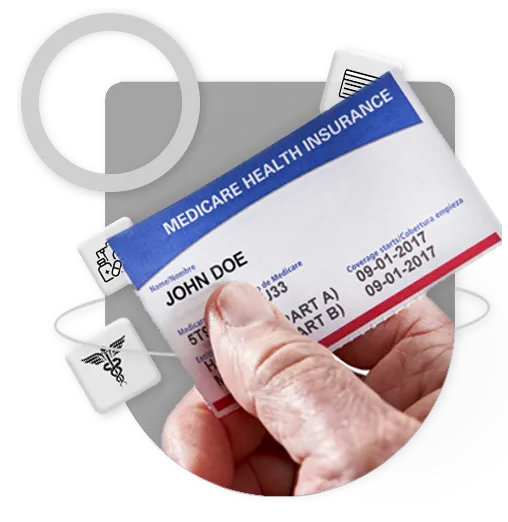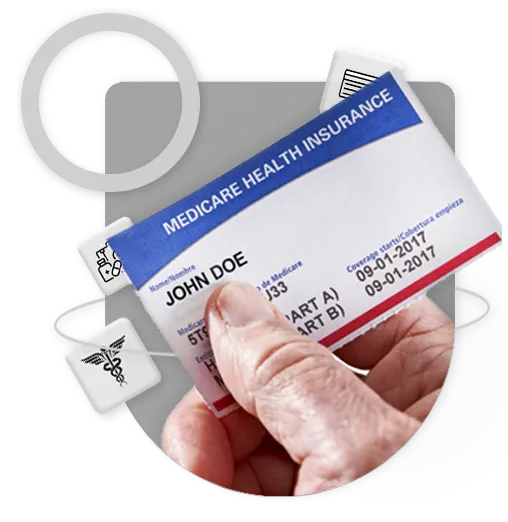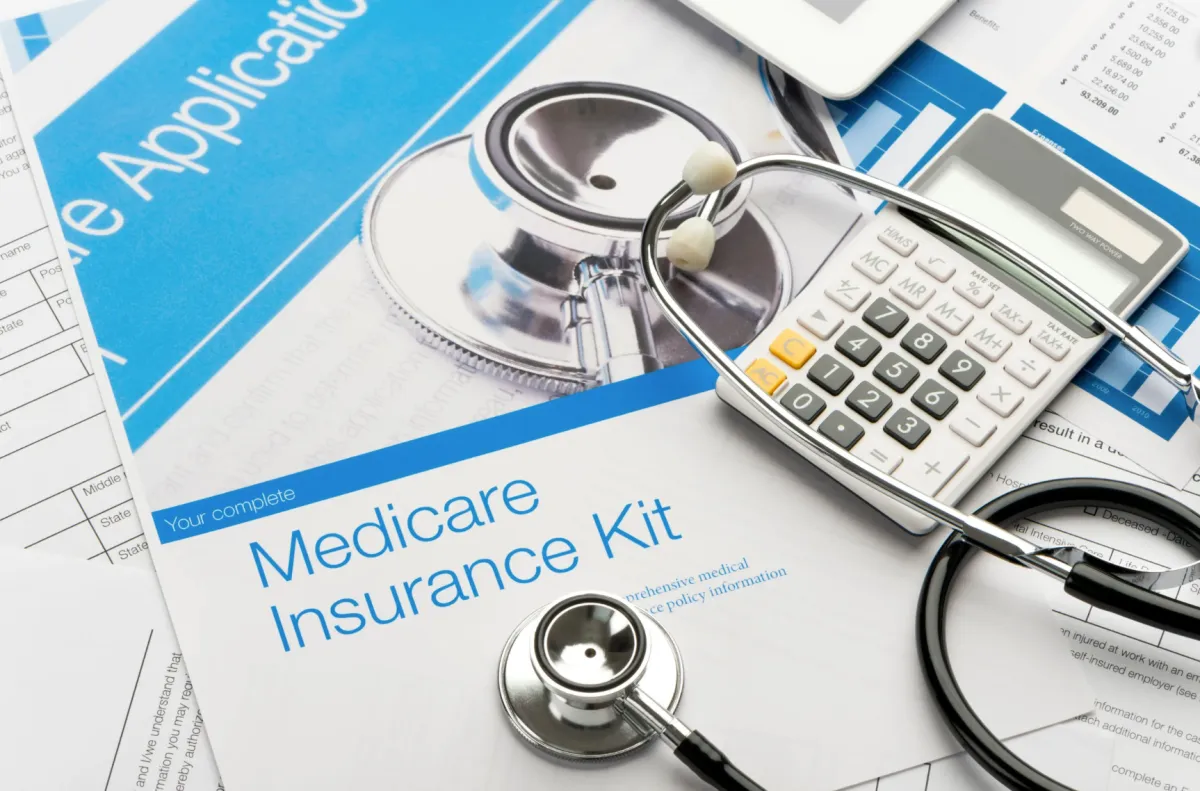What is Medicare?
Medicare is a federal health insurance program accessible to individuals who are 65 years and older, as well as to those under 65 with specific disabilities or medical conditions like End-Stage Renal Disease.
It comprises various components, known as Parts A, B, C, and D, each designed to meet different healthcare requirements.

What is Medicare?

Medicare is a federal health insurance program accessible to individuals who are 65 years and older, as well as to those under 65 with specific disabilities or medical conditions like End-Stage Renal Disease.
It comprises various components, known as Parts A, B, C, and D, each designed to meet different healthcare requirements.

Original Medicare
Medicare Parts A and B are referred to as "Original Medicare".
These parts are managed by the federal government. Some individuals who receive Social Security benefits are automatically enrolled in Original Medicare while others need to apply for it as they approach their 65th birthday.

Original Medicare
Medicare Parts A and B are referred to as "Original Medicare".
These parts are managed by the federal government. Some individuals who receive Social Security benefits are automatically enrolled in Original Medicare while others need to apply for it as they approach their 65th birthday.
Medicare Part A (Hospital Insurance)
Medicare Part A includes coverage for inpatient services in hospitals or skilled nursing facilities, as well as home health care and hospice care for patients with terminal illnesses.
Part A Cost
Deductible
You must first meet a Part A deductible before Part A helps with your covered medical expenses.
Options
There is no insurance premium for Part A if you or your spouse have paid into Social Security for a minimum of 10 years.
If not, you have the option to purchase Medicare Part A.
Copays
Copayments or cost-sharing might be required for certain services. This includes prolonged hospital or skilled nursing facility stays.
Coinsurance
Part A has coinsurance for:
• Inpatient hospital care lasting between 61-90 days total per benefit period.
• Inpatient mental health care lasting between 61-90 days total per benefit period.
• Skilled nursing care lasting between 21-100 days total per benefit period.
Coinsurance is also available for a limited number of additional days.
Medicare Part A (Hospital Insurance)
Medicare Part A includes coverage for inpatient services in hospitals or skilled nursing facilities, as well as home health care and hospice care for patients with terminal illnesses.
Part A Cost
Deductible
You must first meet a Part A deductible before Part A helps with your covered medical expenses.
Options
There is no insurance premium for Part A if you or your spouse have paid into Social Security for a minimum of 10 years.
If not, you have the option to purchase Medicare Part A.
Copays
Copayments or cost-sharing might be required for certain services. This includes prolonged hospital or skilled nursing facility stays.
Coinsurance
Part A has coinsurance for:
• Inpatient hospital care lasting between 61-90 days total per benefit period.
• Inpatient mental health care lasting between 61-90 days total per benefit period.
• Skilled nursing care lasting between 21-100 days total per benefit period.
Coinsurance is also available for a limited number of additional days.
Medicare Part A:
Additional Information
You can utilize your coverage anywhere in the United States, as most hospitals in the country participate in Medicare.
Medicare Part B (Medical Insurance)
Medicare Part B provides coverage for doctor visits, durable medical equipment, speech therapy, occupational therapy, physical therapy, and various other outpatient services.
Part B Cost
Deductible
Similar to Part A, you must first meet an insurance deductible before Part B helps with your medical costs.
Copays
Copayments or cost-sharing might be required for certain services, such as those provided in an outpatient hospital setting.
Coinsurance
You are responsible for 20 percent of the cost for certain medical services, including doctor visits, outpatient therapy, and durable medical equipment.
Preventative Care
Medicare-covered preventive care services, including annual wellness visits and mammograms for women, are fully covered. No deductibles, copayments, or coinsurance are required for these services.
Premium
Medicare Part B requires a monthly insurance premium, which depends on your enrollment timing and annual household income.This premium is typically deducted from Social Security benefits.
It is distinct from the premiums for Medigap, Medicare Advantage (Part C), or Prescription Drug Coverage (Part D).
Note about Medicare Part B Limits: Medicare Part B imposes annual limits on services for physical
therapy, occupational therapy, and speech-language pathology.
Medicare Part B (Medical Insurance)
Medicare Part B provides coverage for doctor visits, durable medical equipment, speech therapy, occupational therapy, physical therapy, and various other outpatient services.
Part B Cost
Deductible
Similar to Part A, you must first meet an insurance deductible before Part B helps with your medical costs.
Copays
Copayments or cost-sharing might be required for certain services, such as those provided in an outpatient hospital setting.
Coinsurance
You are responsible for 20 percent of the cost for certain medical services, including doctor visits, outpatient therapy, and durable medical equipment.
Preventative Care
Medicare-covered preventive care services, including annual wellness visits and mammograms for women, are fully covered. No deductibles, copayments, or coinsurance are required for these services.
Premium
Medicare Part B requires a monthly insurance premium, which depends on your enrollment timing and annual household income.This premium is typically deducted from Social Security benefits.
It is distinct from the premiums for Medigap, Medicare Advantage (Part C), or Prescription Drug Coverage (Part D).
Note about Medicare Part B Limits: Medicare Part B imposes annual limits on services for physical
therapy, occupational therapy, and speech-language pathology.
Medicare Part B:
Additional Information
If you have Original Medicare under Part B and your physician accepts Medicare, you can utilize your
coverage anywhere within the United States. You have the freedom to choose any doctor in the country who accepts Medicare patients. Additionally, Part B premiums, standard deductibles, and cost-sharing amounts typically undergo annual adjustments, with changes taking effect on January 1st.
Am I eligible?

You are eligible for Part A at no cost at age 65 if any of the following conditions apply:
You receive or are eligible to receive benefits from Social Security or the Railroad Retirement Board (RRB).
Your spouse (living or deceased, including a divorced spouse) receives or is eligible to receive Social Security or RRB benefits.
You or your spouse worked long enough in a government job where you paid Medicare taxes.
You are the dependent parent of a fully insured deceased child.
Am I eligible?
You are eligible for Part A at no cost at age 65 if any of the following conditions apply:
You receive or are eligible to receive benefits from Social Security or the Railroad Retirement Board (RRB).
Your spouse (living or deceased, including a divorced spouse) receives or is eligible to receive Social Security or RRB benefits.
You or your spouse worked long enough in a government job where you paid Medicare taxes.
You are the dependent parent of a fully insured deceased child.


⭐⭐⭐⭐⭐
Happy Customers
More than clients taken care of!
Medicare Eligibility Before Age 65

Before age 65, you are eligible for Medicare Part A at no cost if any of the following conditions apply:
You’ve received Social Security Disability Insurance (SSDI) benefits for 24 months.
You receive a disability pension from the Railroad Retirement Board (RRB) and meet certain conditions.
You receive SSDI benefits and have Lou Gehrig’s disease (amyotrophic lateral sclerosis).
You worked long enough in a government job where you paid Medicare taxes and have met the requirements of the SSDI program for 24 months.
You are the child or surviving spouse (age 50 or older, including a divorced surviving spouse) of a worker who has worked long enough under Social Security or in a Medicare-covered government job and meet the requirements of the SSDI program.
Kidney Failure Before Age 65

You have permanent kidney failure (end-stage renal disease) and receive maintenance dialysis or a kidney transplant, and one of the following applies:
You’ve worked long enough under Social Security or the railroad retirement system.
You’ve worked long enough in a Medicare-covered government job.
You are the child or spouse (including a divorced spouse) of a worker (living or deceased) who has worked long enough under Social Security or the railroad retirement system, or in a Medicare-covered government job.
*Note: Anyone eligible for Medicare Part A at no cost can enroll in Medicare Part B by paying a monthly premium. Those with higher incomes may have to pay a higher monthly premium for Part B.
If you are not eligible for Part A at no cost, you can purchase Part B without needing to buy Part A. To be eligible, you must be age 65 or older and meet one of the following criteria:
Be a U.S. citizen.
Be a lawfully admitted noncitizen who has lived in the United States for at least 5 years. You can only sign up for Part B during designated enrollment periods. If you don't enroll in Part B when you are first eligible, you may have to pay a late enrollment penalty for as long as you have Part B coverage.

Medicare Eligibility Before Age 65
Before age 65, you are eligible for Medicare Part A at no cost if any of the following conditions apply:
You’ve received Social Security Disability Insurance (SSDI) benefits for 24 months.
You receive a disability pension from the Railroad Retirement Board (RRB) and meet certain conditions.
You receive SSDI benefits and have Lou Gehrig’s disease (amyotrophic lateral sclerosis).
You worked long enough in a government job where you paid Medicare taxes and have met the requirements of the SSDI program for 24 months.
You are the child or surviving spouse (age 50 or older, including a divorced surviving spouse) of a worker who has worked long enough under Social Security or in a Medicare-covered government job and meet the requirements of the SSDI program.
Kidney Failure Before Age 65
You have permanent kidney failure (end-stage renal disease) and receive maintenance dialysis or a kidney transplant, and one of the following applies:
You’ve worked long enough under Social Security or the railroad retirement system.
You’ve worked long enough in a Medicare-covered government job.
You are the child or spouse (including a divorced spouse) of a worker (living or deceased) who has worked long enough under Social Security or the railroad retirement system, or in a Medicare-covered government job.

*Note: Anyone eligible for Medicare Part A at no cost can enroll in Medicare Part B by paying a monthly premium. Those with higher incomes may have to pay a higher monthly premium for Part B.
If you are not eligible for Part A at no cost, you can purchase Part B without needing to buy Part A. To be eligible, you must be age 65 or older and meet one of the following criteria:
Be a U.S. citizen.
Be a lawfully admitted noncitizen who has lived in the United States for at least 5 years. You can only sign up for Part B during designated enrollment periods. If you don't enroll in Part B when you are first eligible, you may have to pay a late enrollment penalty for as long as you have Part B coverage.
Medicare Parts A And B – Enrollment
Initial Enrollment: The Initial Enrollment Period is a limited timeframe during which you can sign up for Original Medicare (Part A and/or Part B) when you first become eligible.
Once enrolled in Medicare Parts A and B, you have the option to choose additional coverage, such as Medicare Advantage, Medigap, or Part D, from approved private insurers.
Individuals Aged 65 or Older
Your Initial Enrollment Period is determined by the month you turn 65. It starts three months before your birth month and continues until three months after your birth month.
Your enrollment period lasts 7 months, based on the month you turn 65.
Example: If your birthday is January 12th, 1958, your enrollment period would be October 1st, 2022 - April 30th, 2023.
Eligible Enrollment Months:

Medicare Parts A And B – Enrollment
Initial Enrollment: The Initial Enrollment Period is a limited timeframe during which you can sign up for Original Medicare (Part A and/or Part B) when you first become eligible.
Once enrolled in Medicare Parts A and B, you have the option to choose additional coverage, such as Medicare Advantage, Medigap, or Part D, from approved private insurers.
Individuals Aged 65 or Older
Your Initial Enrollment Period is determined by the month you turn 65. It starts three months before your birth month and continues until three months after your birth month.
Your enrollment period lasts 7 months, based on the month you turn 65.
Example: If your birthday is January 12th, 1958, your enrollment period would be October 1st, 2022 - April 30th, 2023.
Eligible Enrollment Months:

Attention: Individuals Under Age 65 with an Eligible Disability
Your Initial Enrollment Period is determined by when you started receiving Social Security or Railroad Retirement Board (RRB) disability benefits. It begins in the 22nd month after you start receiving benefits and lasts until the 28th month after that.
Example: If you began receiving disability benefits in January 2022, your Initial Enrollment Period is from November 1, 2023 until May 31, 2023.

Attention: Individuals Under Age 65 with an Eligible Disability
Your Initial Enrollment Period is determined by when you started receiving Social Security or Railroad Retirement Board (RRB) disability benefits. It begins in the 22nd month after you start receiving benefits and lasts until the 28th month after that.
Example: If you began receiving disability benefits in January 2022, your Initial Enrollment Period is from November 1, 2023 until May 31, 2023.

How To Enroll
If you already receive Social Security or certain retirement benefits, you may be automatically enrolled in Original Medicare during this time period.
Open Enrollment Period
(October 15 through December 7)
The Medicare Open Enrollment Period offers an annual chance to review and modify your Medicare coverage.
You can:
Enroll in a Medicare Advantage (Part C) plan.
Discontinue your Medicare Advantage plan and switch back to Original Medicare (Part A and Part B).
Switch from one Medicare Advantage plan to another.
Add or adjust your Prescription Drug.
Coverage (Part D) plan if you are enrolled in Original Medicare.
General Enrollment Period
(January 1 through March 31)
The General Enrollment Period presents an annual chance to enroll in Medicare Part A and/or Part B.
You can:
Sign up for Original Medicare if you weren't automatically enrolled and missed your Initial Enrollment Period.
Enroll in Part B if you have chosen to opt out of automatic enrollment or have previously dropped your coverage.
Note: If you enroll in Part B after your Initial Enrollment Period, you may incur higher premiums unless you qualify for a Special Enrollment Period.
If you enroll in Medicare during this period, your coverage begins on July 1.
* Note: In certain situations, you may qualify for a Special Enrollment Period. This period provides an opportunity to enroll in the Medicare program or make changes to your Medicare options outside of the Initial and annual Open Enrollment Periods.
How To Enroll
If you already receive Social Security or certain retirement benefits, you may be automatically enrolled in Original Medicare during this time period.
Open Enrollment Period
(October 15 through December 7)
The Medicare Open Enrollment Period offers an annual chance to review and modify your Medicare coverage.
You can:
Enroll in a Medicare Advantage (Part C) plan.
Discontinue your Medicare Advantage plan and switch back to Original Medicare (Part A and Part B).
Switch from one Medicare Advantage plan to another.
Add or adjust your Prescription Drug.
Coverage (Part D) plan if you are enrolled in Original Medicare.
General Enrollment Period
(January 1 through March 31)
The General Enrollment Period presents an annual chance to enroll in Medicare Part A and/or Part B.
You can:
Sign up for Original Medicare if you weren't automatically enrolled and missed your Initial Enrollment Period.
Enroll in Part B if you have chosen to opt out of automatic enrollment or have previously dropped your coverage.
Note: If you enroll in Part B after your Initial Enrollment Period, you may incur higher premiums unless you qualify for a Special Enrollment Period.
If you enroll in Medicare during this period, your coverage begins on July 1.
* Note: In certain situations, you may qualify for a Special Enrollment Period. This period provides an opportunity to enroll in the Medicare program or make changes to your Medicare options outside of the Initial and annual Open Enrollment Periods.

More Info
Important Questions
Automatic Enrollment:
Question: Will I be automatically enrolled in Medicare?
You will be automatically enrolled in Medicare Part A and Part B if you reach age 65 and receive Social Security or Railroad Retirement Board (RRB) retirement benefits. You will also be automatically enrolled if you are under age 65 with an eligible disability.
You will receive a Medicare card in the mail three months before your 65th birthday or your 25th month of disability. It will include instructions for opting out of enrollment for Part B, should you wish to do so.
Manual Enrollment:
If you are not already receiving Social Security benefits, you will not receive a reminder letter. The enrollment period is crucial: you can start signing up three months before your 65th birthday and have until three months after your birth month to complete the process.
Missing this deadline could result in higher premiums.
Question: How do I manually enroll in Medicare?
There are 3 enrollment periods for Medicare. It's important to sign up as soon as possible to avoid penalties or gaps in coverage. You can sign up at: https://www.ssa.gov/medicare/sign-up

More Info
Important Questions
Automatic Enrollment:
Question: Will I be automatically enrolled in Medicare?
You will be automatically enrolled in Medicare Part A and Part B if you reach age 65 and receive Social Security or Railroad Retirement Board (RRB) retirement benefits. You will also be automatically enrolled if you are under age 65 with an eligible disability.
You will receive a Medicare card in the mail three months before your 65th birthday or your 25th month of disability. It will include instructions for opting out of enrollment for Part B, should you wish to do so.
Manual Enrollment:
If you are not already receiving Social Security benefits, you will not receive a reminder letter. The enrollment period is crucial: you can start signing up three months before your 65th birthday and have until three months after your birth month to complete the process.
Missing this deadline could result in higher premiums.
Question: How do I manually enroll in Medicare?
There are 3 enrollment periods for Medicare. It's important to sign up as soon as possible to avoid penalties or gaps in coverage. You can sign up at: https://www.ssa.gov/medicare/sign-up
Looking for a First-Class Medicare Broker?
Looking for a First-Class Medicare Broker?
Licensed Insurance Professional. This material has been provided by a licensed insurance professional for informational and educational purposes only and is not endorsed or affiliated with the Social Security Administration or any government agency. It is not intended to provide, and should not be relied upon for, accounting, legal, tax or investment advice.
© 2025 Akroamatik Financial - All Rights Reserved

